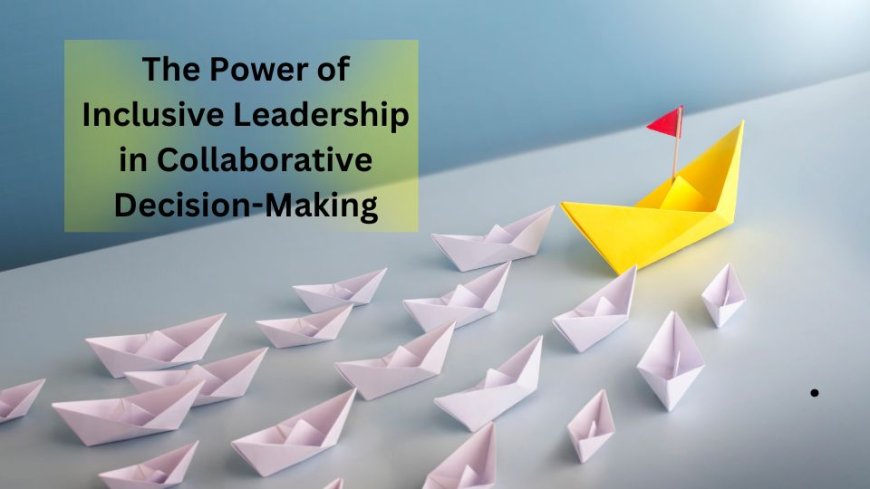The Power of Inclusive Leadership in Collaborative Decision-Making
In today’s fast-paced business environment, innovation is not a luxury but a necessity. At the core of innovation lies diversity and open-mindedness, values that organizations must embrace to thrive.

Creating an environment where every team member feels valued and respected is not just about ethics—it's a strategic imperative. This is where inclusive leadership plays a crucial role.
What is Inclusive Leadership?
Inclusive leadership is the ability to embrace diversity and cultivate a culture where all employees can thrive, contributing their best to achieve organizational success. An inclusive leader recognizes and leverages diverse perspectives, backgrounds, and experiences, ensuring that organizational goals are not just met but exceeded.
The Impact of Inclusivity on Collaborative Decision-Making
Collaborative decision-making goes beyond a mere approach—it’s a mindset. It involves bringing people from all levels of an organization into the decision-making process, and encouraging the sharing of ideas, information, and perspectives to achieve a common goal.
However, a 2020 Gallup study revealed that only 24 percent of managers in the United States feel confident in their organization’s decision-making process. Even more concerning is that just 14 percent are satisfied with how decisions are made and the speed of execution. This reflects a widespread issue in many organizations where decision-making is often treated as an individualized affair rather than a collaborative function.
Why Collaborative Decision-Making Matters
Collaborative decision-making offers numerous benefits that can help organizations avoid pitfalls and enhance overall performance.
-
Enhancing Creativity and Innovation
By fostering an environment where ideas are shared freely, collaborative decision-making leads to the discovery of innovative solutions to complex problems. Brainstorming sessions that include diverse stakeholders can uncover new approaches that may not have been considered in a more siloed decision-making process. Forbes reports that collaboration can boost innovation by up to 50 percent, emphasizing the critical role of inclusivity in driving creativity.
-
Fostering Employee Engagement
When employees are given a voice in the decision-making process, they feel valued and respected. This sense of ownership leads to higher engagement, which in turn produces better outcomes, reduces burnout, and lowers turnover rates. According to Gallup, highly engaged employees are a key driver of organizational success.
-
Uncovering Blind Spots
Interdepartmental collaboration enables organizations to identify and address internal weaknesses and external threats—areas often overlooked in less inclusive environments. This collective self-awareness is particularly important during challenging times, ensuring that all team members are informed and aligned, even when leaders are under pressure.
-
Increasing Decision Quality
Collaborative decision-making pools knowledge and expertise, leading to more informed, accurate, and reliable decisions. It helps to avoid biases and errors, ultimately improving overall performance. Additionally, it challenges the tendency to seek consensus merely for group harmony, ensuring a thorough evaluation of all possible solutions.
Best Practices for Effective Collaborative Decision-Making
To harness the full potential of collaborative decision-making, organizations should consider the following best practices:
-
Define the Problem and the Objective
Clear communication is essential to avoid confusion and minimize conflict. A well-defined problem statement and a clear understanding of the desired outcome can guide the decision-making process and keep the team focused.
-
Establish Psychological Safety
Team members need to feel safe expressing their ideas, questions, or criticisms without fear of retribution. Psychological safety fosters open dialogue, encourages the sharing of diverse perspectives, and enhances collective responsibility for team decisions.
-
Leverage Collective Intelligence
The collective intelligence of a team can surpass the problem-solving ability of any individual member. By fostering inclusivity and empowering all team members to participate in decision-making, organizations can unlock their full potential.
-
Acknowledge and Validate Contributions
Recognizing and appreciating each team member’s contributions fosters a sense of value and respect, which boosts confidence and encourages further engagement. Techniques like the “parking lot” concept can help ensure that valuable ideas are captured for future consideration.
-
Assess Options to Reach a Consensus
After defining the problem and the goal, the team should assess all available options using techniques like SWOT analysis, mind mapping, and brainstorming. A well-considered decision based on collective input is more likely to yield positive outcomes.
-
Adjust Strategy Based on Feedback
Once a decision is implemented, continuous monitoring and feedback are crucial. Insights from stakeholders and performance evaluations should inform any necessary adjustments, ensuring that the strategy remains effective.
Conclusion
Diversity and inclusion in decision-making bring a wealth of perspectives and experiences to the table, leading to more informed and effective decisions. Organizations that empower diverse voices and implement inclusive leadership across all functions can enhance employee engagement, foster teamwork, and drive competitive advantage. By embracing these practices, businesses can cultivate a culture of innovation and collaboration, positioning themselves for long-term success.

